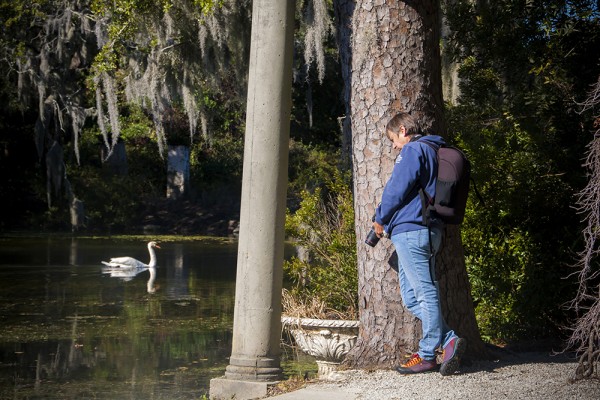“Trees have long thoughts, long-breathing and restful, just as they have longer lives than ours. They are wiser than we are, as long as we do not listen to them. But when we have learned how to listen to trees, then the brevity and the quickness and the childlike hastiness of our thoughts achieve an incomparable joy. Whoever has learned how to listen to trees no longer wants to be a tree. He wants to be nothing except what he is. That is home. That is happiness.” ~ Hermann Hesse
I visited Airlie Gardens while visiting Wilmington, North Carolina.
I admired the antique camellias in bloom and studied Airlie Oak, one of the oldest live oaks in North Carolina estimated to be 467 years old. I sat in century old gardens by the sea, watched as several swans acrobatically supped from an algae covered lake, and played in a bottle house – a house constructed of thousands of colored glass bottles – dedicated to local artist Minnie Evans. And all the while, as I strolled through the 67 acre park with fellow member of the Thoreau Sauntering Club, Debi Bradford, I searched for a tree.
I thought, quite certainly, that the tree I wanted to touch and listen to would be one of the magnificent live oaks. Such majestic trees, ancient, hovering over our heads, draped with Spanish moss. But I passed dozens of oaks. I thought them beautiful and stretched my hands upon several of their trunks. But I didn’t really feel the right connection.
And before anyone begins to think, “woo – woo, she talks to trees”, well . . . I do not talk to trees. But often I do listen to trees. Truly, I do.
Even Hermann Hesse understood the practice of listening to trees.
After an hour of sauntering, we came upon a small formal garden, the Pergola Garden. The structure was built from coquina, crushed shells, in the early 1900s. Water in a three tired fountain gurgled; the leaves on the nearby live oaks rustled.
There, on the fringe, buttressed by the wooden beams, stood a pine tree.
Crushed stone covered its roots which were stretching towards Airlie Lake. It had thousands of pine cones, a few strands of Spanish moss dressed its bare branches, and it didn’t have many needles. An old tree.
It was a sunny space, and since the wind was blowing chilly, we stopped to rest in the sunlight. I reached out, as is my habit, and placed my palm on the pine. Nice. There was a pleasant energy about the pine. So I put both hands on the tree, leaned my head upon the bumpy bark.
I stood there a long time, long enough that my sauntering partner respectfully walked another path, a kindred offer of time and space. I stood there, soaking in the sun, letting my mind wander, and studied the pine, her branches, the moss, the cones and needles. The wood beams squared against her trunk. I waited.
Finally, I searched in my camera bag for pen and paper, found a torn piece from an old check book cover, and scribbled these words:
There is perfection in imperfection.
What you think you must have is not always what you need.
There are alternatives and workarounds.
What I seek while I journey about, I often discover on the journey within.
That is how I listen to a tree.








